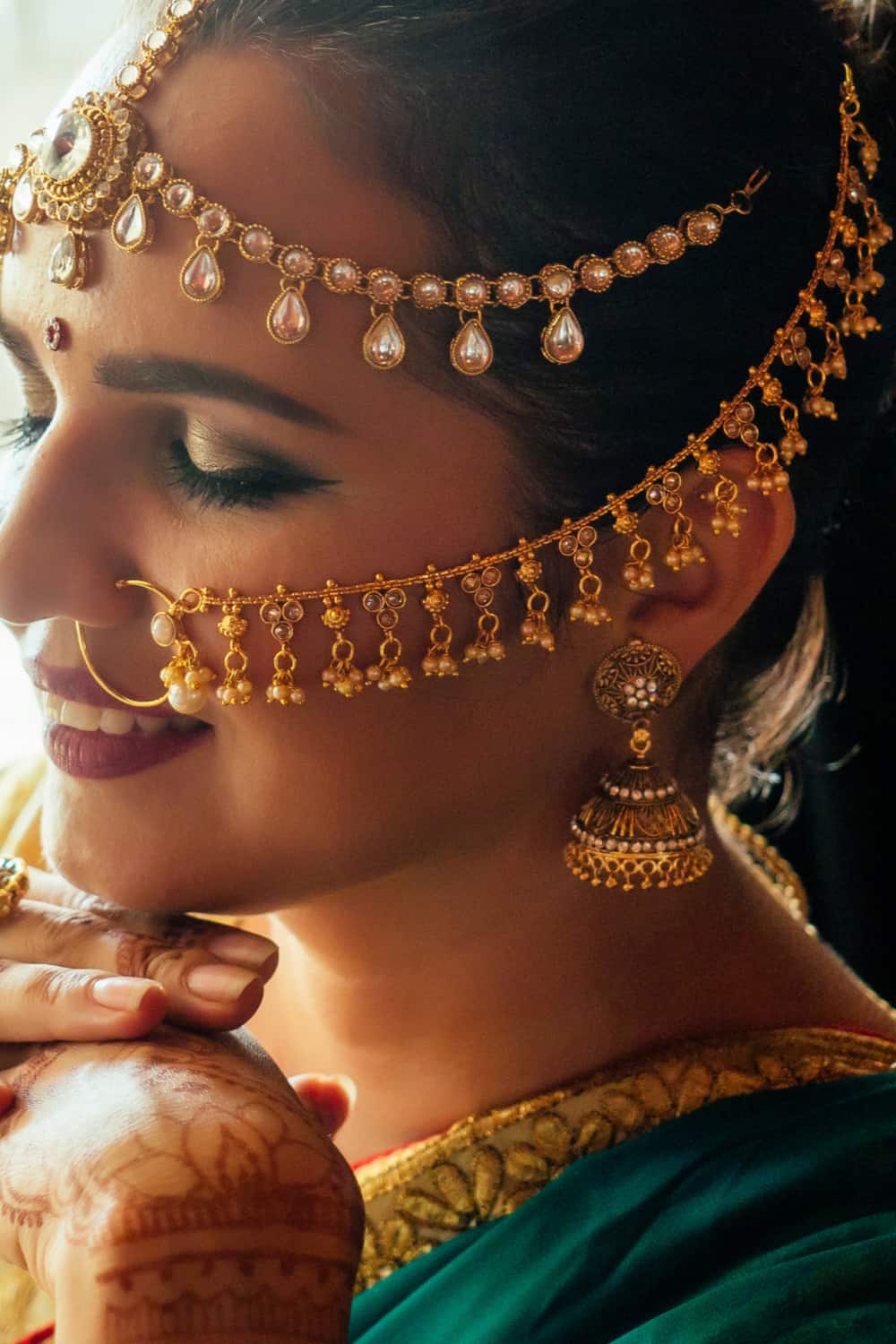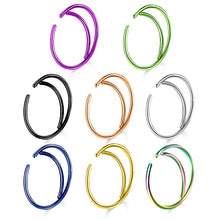The Bible also mentions nose rings in the Old Testament. In the Book of Genesis, 24:22 Abraham gave his future daughter in law a gold nose ring before she married Isaac. On the other hand, the opponents of piercings often quote Leviticus 19:28 that is against any tattoos and body marks.
The mass popularization of piercings began in the 60s and 70s with the emergence of the hippie movement. Young people from all over the globe traveled to India in search of spiritual enlightenment.
Many girls chose to wear the nose ring to symbolize their rebellion against society’s traditional values. The piercing was a symbol of boldness, rebellion, and freedom of choice.
The Symbolic Meaning Of Piercings
A nose ring has various meanings for women, depending on the culture they live in. Among the Beja and Berber tribes in North Africa, it symbolizes wealth and abundance of the family. The bigger the ring, the more respected the family is.
On the day of the wedding, a Berber man gifts his future wife with a nose ring as the sign that he can take care of her and the family. The woman wears that jewelry as a sign of respect for the family she married in.
Contrary, in South Asia, Arunachal tribes fought each other, and they are well-known for robberies and kidnappings of women. Women from of one of the tribes, the Apatani, were considered exceptionally beautiful and attractive.
Therefore, there was a custom to make a woman less appealing by piercing her nose with a large piece of cane and tattooing her face. That protected them from kidnapping and suffering in another tribe. Even today, you can see female descendants of that tribe with traditionally large nose rings.
Traditional Hindu families get the young girl’s nose pierced when they are around 12 and considered ready to marry. The golden nose ring honors the goddesses Luxmi (Goddess of prosperity) and Parvathi (Goddess of marriage).
On the wedding day, women from the family put a ring on a bride’s nose. It often has ornaments with pearls, golden or silver birds, flowers, and fish. In this way, they emphasize her beauty.
Plus, it is not uncommon that the bridal nose ring has a golden chain connected with an earring. The female nose ring is called Nath in India, and it is worn on the left or right nostril, depending on the region from which the bride originates.
Beliefs About Nose Piercing Health Benefits
Connoisseurs of traditional Chinese medicine believe that the left nostril is connected with feminine energy, while the right nose side symbolizes masculine energy. For that reason, girls wear a ring on their left nostrils to relieve their menstrual cramps and other female ailments.
Ayurveda, the Indian alternative medicine, also supports this view. According to this teaching, the left side of the woman’s nose is associated with the reproductive organs and affects fertility.
Ayurveda practitioners believe that wearing a ring on the left nostril can help solve the problem with an irregular menstrual cycle, reduce pain during childbirth, and increase sexual pleasure and libido. Therefore, many married women in India wear a nose ring all the time, believing in its healing effect.
If a young girl suffers from illness or injury, she will choose to pierce her nose as a medical treatment to ease the pain. Plus, she sometimes wears a nose stud as a form of protection from Vashikaran, a dark mantra for seduction and control.
Ayurveda believers also state that the air that woman exhales affects the health of her husband. This superstition is widespread in the rural parts of eastern India. Therefore, the married women wear golden or silver nose rings believing they purify the air they exhale. If a husband passes away before the woman, she takes off the nose ring forever.

Septum Piercing
Throughout history, members of many tribes have preferred the septum ring instead of the nostril piercing. These included Native American, Tibetan, Nepali, Bengal, and other tribes.
The septum piercing went through the nasal septum, between the nostrils. The ring was the most common type, but some tribes used the bars or horseshoe-shaped jewelry, too.
The septum rings made of different materials also represented a status symbol. Wealthier members of the tribe used gold, silver, tusk, or jade, while the lower strata had piercings of stone, animal bones, and wood.
Members of various cultures had the right to wear septum rings while they were forbidden for others. Basically, it depended on the tradition.
The average modern girl won’t pay much attention to tradition when choosing a piercing place. If you consider yourself a spiritual person or you prefer alternative medicine, such as Chinese or Ayurveda, you should pick out the left, feminine side for the nose ring. Traditionally, the piercing on the left nostril is connected with your sensual, womanly energy.
The side of the nose you choose for the piercing will also depend on the symmetry of your face. Habits such as sleeping on a particular side or hairstyle can also influence your decision. If you wear bangs crossed over your face’s left side, it is logical to wear the nose ring on the right side to be more striking and vice versa.
It will help if you take into account whether you are left-handed or primarily use your right hand. The ring placed on the dominant hand side will help you quickly remove the ring when needed. Plus, you should put your nose ring symmetrically with other piercings on the face, if you have them.
Nose Piercing In Modern Society
For example, priests and warriors returning from the conquests used the enemies’ bones to make nose rings. On the other hand, young girls pierced their noses before marriage. The same jewelry, but different purposes!
In most cases, piercing the septum was a ritual that had a strong symbolic meaning. Boys in the Asmat tribe of New Guinea got a septum ring before their first headhunting raid. That ritual signified their adulthood and labeled them as mature men.
In other tribes, a nose ring was the jewelry that the future bride brought as a dowry. The bride’s father pierced her nose to show his wealth. It was also a symbol of courage, fertility, and intelligence.
Nowadays, both men and women wear a septum ring. Celebrities such as Lady Gaga, Alicia Keys, and Rihanna have made this jewelry popular, and many girls choose to follow this trend. Those who are too afraid of pain or infection can get a fake ring as an alternative, which they take off when wanted.

Left Vs. Right Side
As I have already mentioned, the beginning of the hippie movement contributed to the popularization of the nose ring. Young people traveling in Asia considered piercings exotic and accepted them as a form of rebellion against the conventional society they despised.
Piercing as a fashion detail quickly became popular in the US and Europe. With the advent of the Punk movement, it became widely accepted among members of that subculture.
Most parents looked with resentment at nose piercings. Unfortunately, a stigma was created and marked people with nose rings as rebels and apostates from traditional, generally accepted social norms. Even today, some employers reject job candidates who wear the nose ring since they consider them frivolous.
Nowadays, the mythological and religious symbolism of nose rings has almost wholly disappeared. There are no more rules on whether to pierce the septum, left, or right nostrils. Plus, both women and men wear them regardless of whether they are teenagers or adults.
Summary
Wearing a ring has had various meanings for women throughout history, depending on their religion, customs, and ethnicity. However, such symbolism is lost in modern society, and today the nose piercing is a matter of personal choice, style, and preferences.







10 Comments
l like the noise just as a fashion look.
This is all well and good, but why do white girls who grew up in North America or in Western Europe want to have their respective septa pierced and have inserted into the hole a ring (of the type used to lead cattle around or to keep pigs from digging), or, worse, an an object akin to a bent barbell?
I read an article about young white women in Portland who were accused of the crime of cultural misappropriation for having the temerity to prepare tortillas in a manner that they had discovered while on holiday in Mexico; they were roundly criticised, ultimately cancelled, and effectively ejected from polite society. And yet white women who adopt the jewellery-wearing customs of various rural tribes of India and Native Australians are to be celebrated as edgy and fashion-forward?
Preposterous!
People who pierce their nose are cows
People who pierce their ears are homosexuals
People who pierce their eyelash are on drugs
People who pierce their nose are cows
People who pierce their ears are homosexuals
People who pierce their eyelash are on drugs
Whenever I see a woman wearing a nose ring that goes through the septum, I am instantly repulsed. I think it’s a terrible look and a huge turn off.